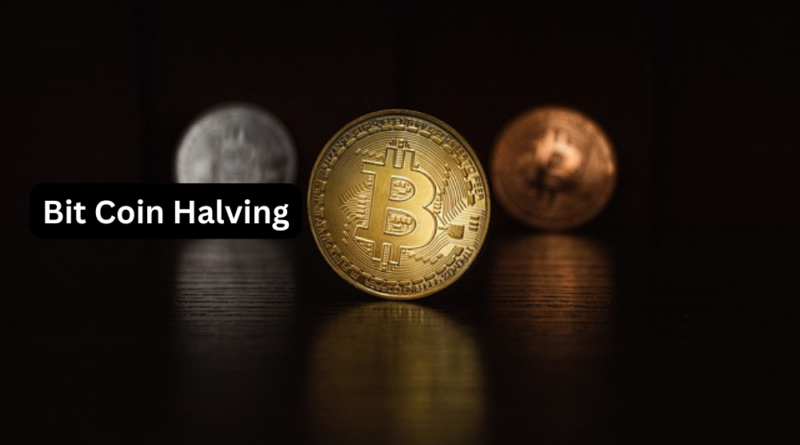Bitcoin Halving: A Key Event in the World of Cryptocurrency
Bitcoin, the first and most well-known cryptocurrency, operates on a decentralized network with a unique process for issuing new coins. One of the most significant events in Bitcoin’s lifecycle is the Bitcoin halving. This event, which occurs approximately every four years, plays a critical role in the cryptocurrency’s economy, affecting everything from its supply to its price volatility.
In this article, we will dive deep into the concept of Bitcoin halving, explain its mechanics, Bit Coin Halving , and its historical significance. We’ll also discuss what to expect from future halvings and how it affects miners, investors, and the broader cryptocurrency ecosystem.
What is Bitcoin Halving?
Bitcoin halving is an event that occurs roughly every four years, during which the reward that miners receive for processing transactions and adding new blocks to the Bitcoin blockchain is halved. This means that the number of new bitcoins created and earned by miners is reduced by 50%.
The process is built into Bitcoin’s protocol as part of its monetary policy to ensure a controlled and predictable supply of new coins. Bitcoin’s total supply is capped at 21 million coins, and halving events are a way of slowing the rate at which new coins are introduced into circulation.
The Mechanism Behind Bitcoin Halving
Bitcoin operates on a system called proof-of-work (PoW), where miners compete to solve complex mathematical puzzles. The first miner to solve the puzzle is rewarded with newly minted bitcoins and transaction fees. Initially, the reward for miners was 50 BTC per block, but over time, this reward is halved at regular intervals, known as “halving.”
Key Points About Bitcoin Halving:
- Halving Schedule: Bitcoin halvings occur roughly every 210,000 blocks, which translates to approximately every four years.
- Initial Reward: When Bitcoin was first launched in 2009 by its pseudonymous creator, Satoshi Nakamoto, the reward for mining a block was 50 BTC.
- Subsequent Halvings:
- The first halving in November 2012 reduced the reward from 50 BTC to 25 BTC.
- The second halving in July 2016 reduced the reward from 25 BTC to 12.5 BTC.
- The third halving took place in May 2020, cutting the reward from 12.5 BTC to 6.25 BTC.
- Future Halvings: The next halving event is expected to occur in 2024, reducing the reward to 3.125 BTC. The final halving will occur around 2140 when all 21 million bitcoins have been mined, and miners will be compensated solely through transaction fees.
Why Does Bitcoin Halving Matter?
1. Impact on Bitcoin Supply
Bitcoin’s halving is designed to ensure that the supply of new bitcoins is gradually reduced over time. With a fixed supply of 21 million coins, halving serves as a deflationary mechanism, making Bitcoin scarcer as time goes on.
Every halving reduces the number of new bitcoins generated by miners, which theoretically creates upward pressure on the price due to the supply-demand dynamic. As fewer new bitcoins are available, demand can outstrip supply, pushing prices higher.
2. Influence on Bitcoin Price
Historically, Bitcoin halvings have been associated with significant price increases. The reduction in the reward for miners leads to a lower supply of new bitcoins on the market, which often coincides with increased demand. While past performance is not a guarantee of future results, many investors and analysts expect Bitcoin’s price to rise in the lead-up to and after a halving.
For example:
- After the 2012 Halving: Bitcoin’s price increased from around $12 to over $1,000 in the year following the halving.
- After the 2016 Halving: Bitcoin surged from around $650 to nearly $20,000 by December 2017.
- After the 2020 Halving: Bitcoin reached new all-time highs, surpassing $60,000 by early 2021.
3. Effect on Bitcoin Miners
Bitcoin miners are directly impacted by halving events, as their reward for securing the network is reduced. For miners, this means that after each halving, they must adapt to a new economic reality. They need to ensure they can still profit despite earning fewer bitcoins per block.
In some cases, miners with higher operating costs may struggle to remain profitable after a halving, especially if the price of Bitcoin does not rise quickly enough to compensate for the reduced rewards. However, miners are also incentivized to optimize their operations to stay competitive. If the price of Bitcoin increases after a halving, mining can remain profitable even with the lower reward.
4. Bitcoin’s Deflationary Nature
Bitcoin’s halving mechanism also gives the cryptocurrency a deflationary characteristic. Unlike traditional fiat currencies, which can be inflated by central banks printing more money, Bitcoin’s supply is predetermined and cannot be changed. This gives it the potential to preserve value over time, making it an attractive option for investors seeking to hedge against inflation or economic instability.
The Economic and Market Impact of Bitcoin Halving
1. Investor Sentiment and Speculation
Halvings are often seen as a major milestone in the cryptocurrency world. Leading up to and following a halving event, there tends to be a surge in speculation, as many investors believe the reduction in supply will lead to higher prices. This speculative nature often drives short-term volatility in the market, with prices swinging in anticipation of what will happen after the halving.
While many investors hold onto their Bitcoin in hopes of long-term profits, others may capitalize on price increases by selling. It’s important to note that Bitcoin halvings often result in both immediate and long-term market shifts, making it essential for investors to carefully analyze the situation before making moves.
2. Increased Media Coverage
Bitcoin halvings tend to attract significant media attention, which helps increase public awareness and bring new investors into the market. This surge in awareness often leads to increased demand for Bitcoin, further amplifying the effects of the halving on price and market dynamics.
Challenges and Criticisms of Bitcoin Halving
While Bitcoin halving is often seen as a positive event for Bitcoin’s value, it does come with its challenges and criticisms:
1. Mining Difficulty and Centralization
As the reward decreases, smaller, less efficient miners may be forced out of the market, leading to increased centralization of mining power. Large mining pools with better equipment and cheaper electricity costs are more likely to survive, which could potentially reduce the decentralized nature of Bitcoin’s network.
2. Market Volatility
Halvings often lead to increased market volatility, both before and after the event. While the halving creates excitement and anticipation, it can also lead to sharp price swings, which may deter some investors from entering the market. For example, the price could drop unexpectedly after the halving if demand does not meet expectations.
What to Expect from Future Bitcoin Halvings
As Bitcoin approaches its next halving event in 2024, many experts are closely watching the potential impact on the cryptocurrency’s price and overall market dynamics. If history is any guide, we can expect an increase in media attention, heightened speculation, and potential price volatility as the halving approaches.




